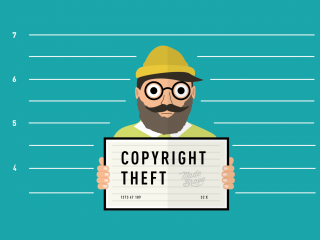Thinking of posting that meme? Hold up! Here’s the 411 on copyright infringement and the creative industries.
In this day and age, social media and t’internet makes it easier for people to access and share things they like – which is great, to a certain degree. Don’t get us wrong, we’re big fans of viral content (social media geeks et al) but a lot of the time, things are shared without giving credit. For creatives, this can mean their work is copied, posted and even sold without their permission (which is pretty rubbish) and as a result, other people benefit from their hard work. The thing is, a lot of companies don’t realise they’re doing any harm – and this is just the result of popular belief or misconception. To clear things up, we had a chat with Philip Hannay of Cloch Solicitors (a real life Lawyer) about copyright infringement and the creative industries.
For those who don’t know – what exactly is copyright infringement?
Put simply, copyright is the legal right to deal in original creative work, and copyright infringement is the generally the theft of such work by indefensible dealing.
What counts as copyright infringement?
The Copyright, Designs and Patents Act 1988 states that “copyright in a work is infringed by a person who without the licence of the copyright owner does, or authorises another to do, any of the acts restricted by the copyright”. The ‘acts’ referred to include:
• Copying the work
• Issuing copies of the work to the public
• Renting or lending the work to the public
• Performing, showing or playing the work in public
• Communicating the work to the public
• Making an adaptation of the work
The owner of the copyright in a work has the exclusive right to undertake (or authorise the undertaking) the foregoing acts in the United Kingdom (directly or indirectly, and in relation to whole or any substantial part of the work).
It is also copyright infringement to:
• Import an infringing copy of the work
• Possess or deal with infringing copy;
• Provide means for making infringing copies
• Permitting use of premises for infringing performance
• Provision of apparatus for infringing performance.
What’s the difference between copyright and trademark infringement?
A copyright work is typically a literary, dramatic, musical or artistic work, a sound recording, film or broadcast, or the typographical arrangement of a published edition. While a trademark typically consists of words (including personal names), designs, letters, numerals or the shape of goods or their packaging. Copyright seeks to protect the labour involved in the aforementioned creative works. While trademark rights exist to protect the ability of a sign to distinguishing goods or services of one trader from those of other traders.
Using an identical or similar sign in trade in connection with identical or similar goods and/or services offered by another trader (who used the mark before you) is likely to amount to infringement of trademark rights. This is particularly true where there exists a likelihood of confusion on the part of the public, which includes the likelihood of association with the trademark, or where the trademark has a reputation in the United Kingdom and the use of the sign, being without due cause, takes unfair advantage of, or is detrimental to, the distinctive character or the repute of the trademark.
What’s the penalty for copyright infringement?
In the UK, in a civil action the penalty for copyright infringement may include relief in the form of a payment to address the damage caused by the infringement, an order to stop (interdict) further infringement, confiscation of any equipment used to infringe copyright, and/or an account of the profits derived from the infringing act(s). This is not an exhaustive list.
Copyright infringement may also attract criminal liability, which may include a prison sentence of up to 10 years and/or a £50,000 fine. Such liability will depend on the circumstances and may also apply to the directors of any company which is found to have infringed.
How do you think this applies to the online generation in terms of social media?
If use is in a business context, stop and think first before copying or using an image. Just because the work is online does not mean it is free to use. Most (if not all) social media companies specifically disclaim responsibility for infringement of intellectual property rights caused by their users. Ignorance and negligence are not defences. Do your own research.
Equally, even if use is being made online on a personal basis, caution is necessary. Moral rights also apply to many copyright works. These moral rights include the right of attribution (crediting). If such rights have been asserted (for example in the terms and conditions on a website), then even if the would-be infringer has a defence to copying the work and communicating the work to the public, moral rights may still be infringed by failure to credit the source. Moreover, often when works such as images are copied and processed across social media platforms the information in the metadata attached to those works (e.g. who the author is) may become wiped, thus orphaning the work.
What are your top tips for people before sharing content from the internet?
In terms of sharing content:
• Find the source of the work and, if possible, the terms on which the work was first broadcast/published. If the work appears on a social media site, ask the account holder where they obtained the image and on what terms. It may be that they paid a library (e.g. Getty Images) for use of the licence.
• Ask for permission to use the work. You will be amazed how often copyright owners will allow use of work subject to accreditation – however a deal of this nature should not be assumed.
• Copyright does not last forever. Check if copyright still resides in the work in question. If the work is orphaned, and you have a record of your search and attempts at finding the owner, check out the ability to obtain a Government guarantee to use the image via the UK Intellectual Property Office.
• Try looking for alternative work(s). It may be that it is quicker to locate a work the use of which is royalty-free work then source and contract with the owner of the original target.
• Perhaps there is the ability to create your own work?
In terms of your own work online:
• Keep records of all your original work and where this work is displayed, performed or recorded
• Use the “©” symbol with your name and date, where appropriate
• If something is a collaboration, reach a written agreement with your collaborator(s) to avoid disputes
• If you use photographs online, consider DMCA (watermarking) protection so they cannot be copied
• Be confident to ask questions, use licenses (such as the creative commons licenses) and find out how others intend to use your work when reaching agreements.
Controlling your copyright and moral rights does not have to be all about commercial exploitation – it gives you the power to control the use of your work in all settings in a way that allows you to govern your creative and professional brand and reputation. Being aware of and controlling your copyright and moral rights can restrict unauthorised use and gives you the comfort that your creative output remains exclusively yours.



